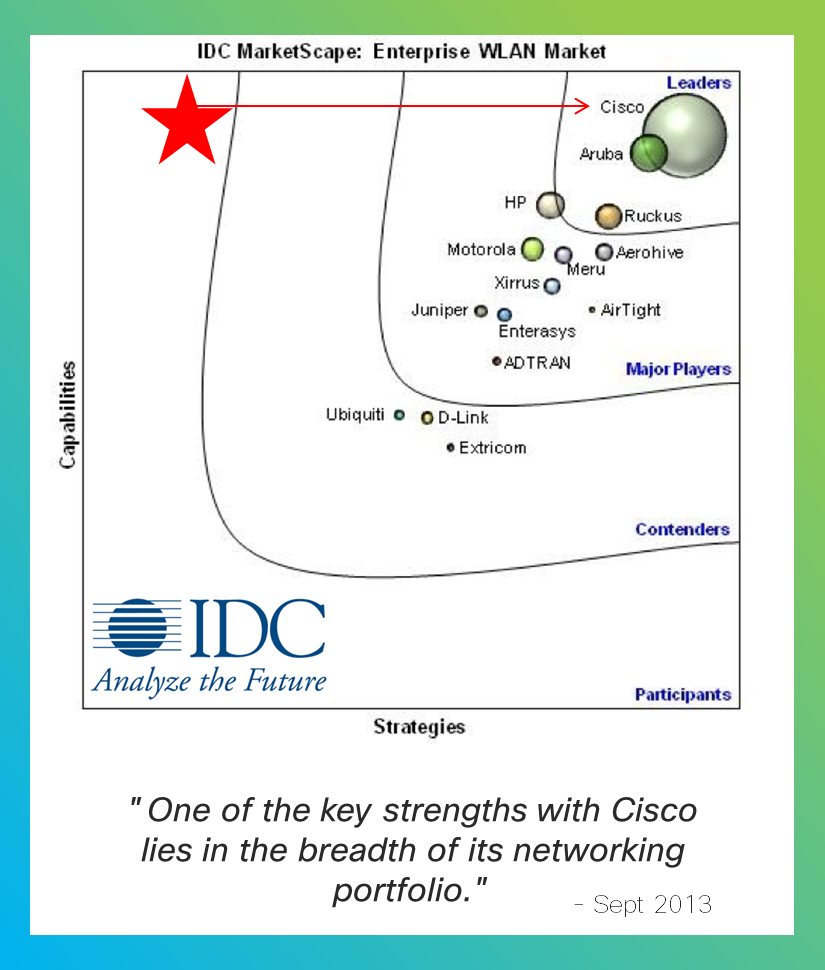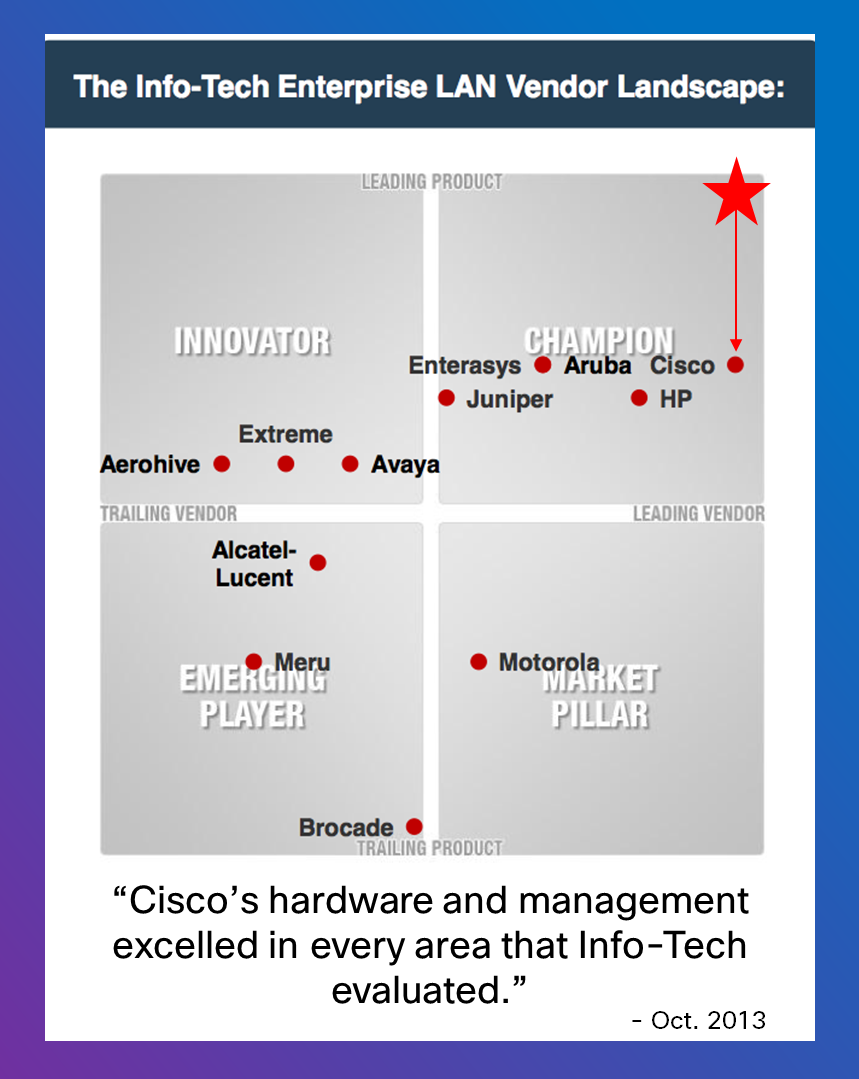 2013: A Year of Growth and Innovation for Cisco WLAN
2013: A Year of Growth and Innovation for Cisco WLAN
As we approach the end of 2013, I feel it is important to reflect on what an important year it has been for Cisco in mobility. 2013 marked continued growth in the WLAN space overall. It’s exciting to to see the continued gain in market share. Innovation has been a key differentiation against our competitors, and we will continue to strive towards providing the best solutions for our customers’ current and future needs. I truly believe the preservation of our market growth is attributed to the cutting-edge solutions that only Cisco can offer to meet the increasingly complex challenges of mobility in the enterprise, BYOD and beyond.
We celebrated many milestones and accomplished a lot this past year. When Gartner released their 2013 Wired and Wireless LAN Infrastructure Magic Quadrant, Cisco was recognized as a leader for the second time in a row (for more details, see this recent blog by Prashanth Shenoy). Cisco has been a leading contributor to drive the latest 802.11ac standard and, in April, we added 802.11ac into our WLAN portfolio when we launched the 802.11ac Module. Taking advantage of the modular architecture of the Aironet 3600, the 802.11ac Module allows new and existing AP 3600 customers to take advantage of the latest wireless standards, which offers enhanced performance for bandwidth-hungry applications, while also addressing the density needs that are prevalent in a growing BYOD environment. A secondary benefit to this modular approach is the ability to provide investment protection, which means that customers with existing Cisco 3600 AP no longer need to “rip and replace” their existing wireless access points. This modularity is only available on Cisco access points.
 We followed up in October with the release of the Aironet 3700 Access Point, which supported an integrated 802.11ac radio. We carried over the modular approach on this powerful access point to be prepared for the second wave of 802.11ac that is on the horizon, continuing to protect our customers’ investments. What makes the AP 3700 truly stand out is Cisco’s innovative approach on how to optimize the customer’s experience by capturing the benefits of the new 802.11ac standard. This approach is exemplified in the unique High Density Experience solution (HDX), which provides customers with not only increased bandwidth through 802.11ac, but also a purpose-built chipset designed specifically for High Density Network Environments that utilize mission-critical, high-performance applications such as video conferencing, on-demand video and large file backups or transfers.
We followed up in October with the release of the Aironet 3700 Access Point, which supported an integrated 802.11ac radio. We carried over the modular approach on this powerful access point to be prepared for the second wave of 802.11ac that is on the horizon, continuing to protect our customers’ investments. What makes the AP 3700 truly stand out is Cisco’s innovative approach on how to optimize the customer’s experience by capturing the benefits of the new 802.11ac standard. This approach is exemplified in the unique High Density Experience solution (HDX), which provides customers with not only increased bandwidth through 802.11ac, but also a purpose-built chipset designed specifically for High Density Network Environments that utilize mission-critical, high-performance applications such as video conferencing, on-demand video and large file backups or transfers.
Having a great experience on a wireless network is more than just higher data rates. You need to have RF excellence that is focused on enhancing the end-user experience. That is why we added new technology and released the next version of our Industry leading CleanAir and ClientLink technologies. We also added Optimized Roaming and Turbo Performance to meet the demands of high-density environments, including:
- For CleanAir we added support for the 80MHz band that is used for 802.11ac, allowing us to extend our proven RF interference and remediation technology to the 802.11ac band.
- For ClientLink we released ClientLink 3.0—a technology that specifically focuses on mixed-client networks, optimizing overall network capacity by helping to ensure that 802.11a/n and 802.11ac clients operate at the best possible rates, especially when they are near cell boundaries.
- Optimized Roaming consistently searches for the optimal access point for mobile devices to connect to, greatly improving end-user experience.
- Turbo Performance testing results have shown that it allows the AP 3700 to scale to 60+ clients, with each client running media rich video or interactive traffic without any performance degradation as it scales. This is especially important in high client density networks. Competitors are at 10 or 20 clients.
Many competitive solutions will claim similar functionality, but it is clear that without purpose-built chipsets designed for the single purpose of improving wireless performance, these solutions fall short.
Since their release, it is no surprise that our 802.11ac products have been deployed into a wide variety of networks including The University of New South Wales, who embraced our solution by deploying one of the largest 802.11ac in Australia, and Houston Methodist Hospital, who is delivering high-definition still and video imaging applications at the patient’s bedside. We also deployed this into manufacturing plants, hotels, and resorts as well as many K-12 school districts. In fact, according to Dell’Oro, 43% of all 802.11ac APs shipped in Q3FY13 are from Cisco, with the next competitor lagging behind at just 17%. With the release of the AP 3700 and our continued dedication to 802.11ac, we expect many more customers will turn to Cisco for higher performance for their networks as demonstrated in a recent independent performance test.
 These innovations have caught the eye of many analysts including IDC, Current Analysis, and Info-Tech—all placing Cisco as the leader in Unified Access or Wireless LAN. IDC wrote in its Marketscape for Enterprise WLAN Market, “One of the key strengths with Cisco lies in the breadth of its networking portfolio.” Similarly, Current Analysis wrote in their Enterprise WLAN Product Assessment report, “Cisco is the leader in the enterprise WLAN solution marketplace.” Info-Tech Research Group also showed Cisco as a champion in Enterprise LAN Vendor Landscape noting that “Cisco’s hardware and management excelled in every area that Info-Tech evaluated.” And, this is only the beginning.
These innovations have caught the eye of many analysts including IDC, Current Analysis, and Info-Tech—all placing Cisco as the leader in Unified Access or Wireless LAN. IDC wrote in its Marketscape for Enterprise WLAN Market, “One of the key strengths with Cisco lies in the breadth of its networking portfolio.” Similarly, Current Analysis wrote in their Enterprise WLAN Product Assessment report, “Cisco is the leader in the enterprise WLAN solution marketplace.” Info-Tech Research Group also showed Cisco as a champion in Enterprise LAN Vendor Landscape noting that “Cisco’s hardware and management excelled in every area that Info-Tech evaluated.” And, this is only the beginning.
As we move into 2014, we will continue to innovate and commit to providing our customers with the best solutions. I’m delighted with the progress in our wireless business in 2013, and I am excited about where we are headed in 2014.


When will your products include a second wired gig port? Cabling contractors need to understand the long term direction and install today for tomorrow!